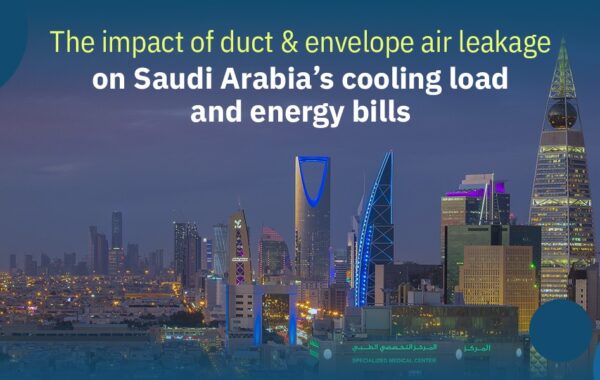
Meeting Building Codes and Performance Standards with Aeroseal
In Saudi Arabia, the demand for modern, efficient, and sustainable commercial buildings is higher than ever. Government projects, healthcare facilities, universities, airports, and office towers are all expected to comply with strict building codes while delivering reliable performance. Contractors and facility managers face growing pressure to meet regulations on air quality, energy efficiency, and airtightness and failing to comply can delay occupancy permits and increase costs.
This is where Aeroseal’s duct and envelope sealing technology plays a vital role. It simplifies compliance, improves building performance, and helps projects meet the requirements of both local and international standards.
Why Building Code Compliance Matters in Saudi Arabia
Every commercial building must meet the Saudi Building Code (SBC), which is designed to ensure occupant safety, energy efficiency, and long-term durability. The SBC incorporates international standards such as ASHRAE 90.1 (energy efficiency) and ASHRAE 62.1 (indoor air quality), both of which set strict requirements for HVAC performance and airtight duct systems.
Non-compliance can lead to:
- Costly delays in obtaining occupancy certificates.
- Higher operating expenses from energy loss.
- Poor indoor air quality that affects health and comfort.
- Increased maintenance and operational risks.
By addressing air leakage and duct performance early in construction, contractors can avoid penalties, streamline inspections, and deliver projects that meet Saudi Arabia’s performance goals under Vision 2030.
The Role of Aeroseal in Meeting Codes and Standards
Traditional duct sealing methodssuch as tape, mastic, or manual sealingare labor-intensive and often unreliable, especially in large commercial buildings with hidden or hard-to-reach ductwork. Aeroseal offers a technology-driven solution that directly addresses these challenges.
- Automated Sealing Process: Aeroseal’s aerosolized sealant is injected into the duct system, sealing leaks from the insideeven in inaccessible areas.
- Real-Time Verification: The system measures and verifies leakage reduction during the process, providing documented proof of compliance.
- High Performance: Aeroseal can reduce duct leakage by up to 95%, ensuring systems meet ASHRAE and SBC standards.
For contractors, this means faster inspections, fewer callbacks, and consistent results across projects of any size.
Aligning with Key Standards
1. Saudi Building Code (SBC)
The SBC incorporates global best practices while considering the Kingdom’s unique climate. Air sealing with Aeroseal ensures HVAC systems meet energy efficiency requirements and minimize air leakage, critical in hot desert conditions where cooling loads are high.
2. ASHRAE 90.1 – Energy Efficiency
ASHRAE 90.1 sets minimum efficiency requirements for commercial buildings. Duct leakage directly impacts energy performance, so proper sealing is essential to compliance. Aeroseal helps contractors meet and exceed these standards, reducing wasted energy and lowering operating costs.
3. ASHRAE 62.1 – Indoor Air Quality
This standard regulates ventilation and air distribution in commercial spaces. Leaky ducts can pull in dust, humidity, and pollutants, reducing air quality in places like hospitals, schools, and offices. Aeroseal ensures air is delivered cleanly and efficiently to the intended spaces.
4. LEED & Green Building Certifications
Saudi Arabia’s Vision 2030 encourages sustainable construction. Aeroseal contributes to LEED credits by improving energy performance and indoor environmental quality, helping commercial buildings achieve green certifications.
Benefits for Contractors and Building Owners
- Faster Project Completion – By ensuring ducts meet performance standards on the first attempt, Aeroseal reduces the risk of failed inspections and project delays.
- Lower Operating Costs – Buildings with sealed ducts consume less energy, reducing utility bills and long-term expenses.
- Improved Occupant Comfort – Stable air distribution creates consistent temperatures and better indoor environments.
- Compliance Confidence – Real-time testing ensures contractors can present verified results to inspectors and clients.
- Future-Proof Buildings – Meeting international standards positions buildings for future regulatory updates in Saudi Arabia.
Real-World Applications in Saudi Arabia
Aeroseal is already making a difference across commercial sectors:
- Hospitals: Maintaining sterile, contaminant-free air delivery.
- Universities: Enhancing comfort in lecture halls and dormitories.
- Airports: Reducing energy consumption in large-scale HVAC systems.
- Government Buildings: Ensuring compliance with SBC for quick approvals.
- Hotels and Malls: Providing reliable comfort while keeping energy use low.
By focusing on air sealing early in construction or retrofit projects, contractors can deliver buildings that are not only compliant but also cost-effective and sustainable.
Why Aeroseal is the Smarter Choice
Unlike traditional methods, Aeroseal delivers:
- Up to 95% leakage reduction.
- Documented compliance reports for inspectors.
- Minimal disruption during installation.
- Scalability for projects of any size.
This combination of performance and reliability makes it the go-to solution for Saudi contractors, engineers, and facility managers seeking to meet building codes and exceed client expectations.
Final Thoughts
Building codes and performance standards in Saudi Arabia are becoming stricter as part of the Kingdom’s commitment to sustainable development and Vision 2030. For contractors and building owners, meeting these standards is not optionalit’s essential.
Aeroseal’s sealing technology provides a proven, efficient, and reliable way to achieve compliance, improve building performance, and reduce long-term operating costs. Whether you are working on a hospital, office tower, or government facility, Aeroseal ensures you meet code the first time, every time.



